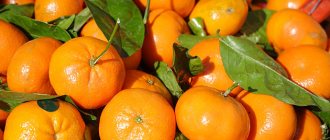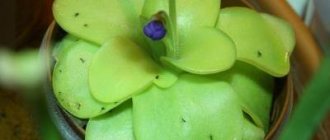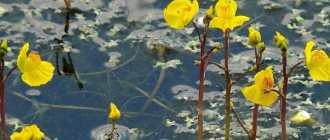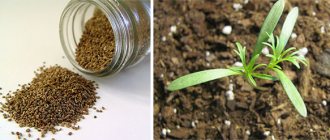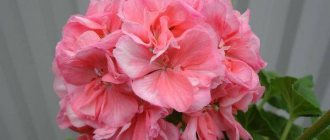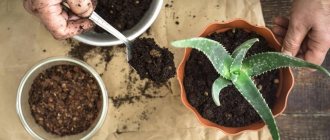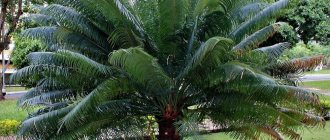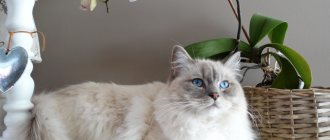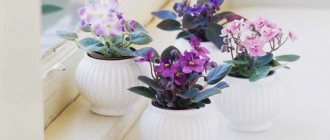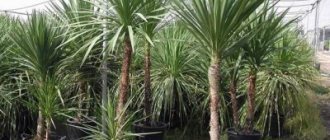Increasingly, amateur gardeners began to have exotic indoor plants - “insectivorous predators.” Having settled such a pet in your home, you need to remember simple but important conditions of care, and then he will live a long and happy life with you. I would like to introduce you closer to typical representatives of carnivorous indoor plants, share my experience of growing them and tell you where you can see an interesting collection of carnivorous flowers.
Carnivorous indoor plants
Insectivores are all those plants that eat small animals and various insects. There are more than 600 species of these on Earth. They are found in the humid tropics of America, Asia, Africa and Australia.
Each plant is unique and has its own trap. The trap is in a stationary state “in standby mode,” but as soon as food falls into it, the active work of the whole plant to digest it immediately begins. Some plants lure their prey with sweet nectar, others begin to move when touched by prey. Some catch the victim with a clap, others rush at him, others suck him in, and still others strike him.
Such properties of plants have become very interesting to many scientists who have studied them over the years. They observed, watched time-lapse footage, studied the chemical composition of enzymes, and even cut up plants. Now a lot is known about them, but as before, plants never cease to amaze us with their diversity and acquired form of survival. ______________________________________________________________________________
You can admire exotic predators in botanical gardens and private greenhouses. Usually there is a corner with a polyudarium and carnivorous plants. In Moscow, such a corner can be seen in the Apothecary Garden. ______________________________________________________________________________
Why did plants start eating living things?
All plants receive nutrition from nutritious soil, but when there is none or the soil is very scarce, some representatives in the process of evolution had to adapt. They began to catch living creatures, and by digesting them, they received the necessary vitality for growth.
Typical and most common carnivorous plants:
- Venus flytrap
- Nepenthes
- Sarracenia
- Sundew
For home cultivation, you can buy cuttings in botanical gardens, seeds on foreign websites or on sale in a large supermarket.
Let's get to know each other better
The principle of dissolution of living beings is used by almost all known insectivorous plants. Most of these are wild flowering or non-flowering species, very attractive in appearance. Some of them can be grown at home by creating the basic conditions - high humidity and periodic feeding with midges, flies, and spiders.
Chinese rose - care and planting at home
Here is a small list of the most famous plants, some of which can be “tamed”:
- Venus flytrap;
- sundew;
- nepenthes;
- butterwort;
- sarracenia;
- Darlingtonia and many, many others
The small leaves, resembling an open shell, exhibit considerable strength and speed. As soon as the fly touches the active “cilia,” the leaf quickly closes, closing the edges and preventing the unfortunate victim from getting out. Very soon, the released enzyme will dissolve the prey in order to feed and develop further.
Nepentoes comes from the Asian tropics, the island of Kalimantan, and is also found in Northern Australia. Long herbaceous stems, strong as steel, climb up the trunks and branches of trees to expose the inflorescences to the sun. And Nepenthes catches midges and flies with specially grown pitcher leaves.
Its large species are peculiarly friendly with some animals - for example, mice feast on tasty nectar and leave their droppings in jugs, a source of nitrogen necessary for nepenthes. Bats use plant pitchers as bedrooms, where they rest quietly, paying for the hospitality with their nitrogenous excrement.
Nepenthes is sold in flower shops, attracting customers with fancy hanging jugs. This is an amazing example of the evolution of a leaf into a trapping organ. Nature tried to stretch the growing leaf as much as possible and form it into an elongated mouth, not forgetting to fit something like a lid so that rain moisture would not dilute the concentrated enzyme at the bottom of the jug.
Sundew is one of the most common plants; it has many sizes, shapes, and colors. It is also found in our swampy places, stagnant lakes, creeks, striking with the thinness of its lines, seeming fragility and enticing with the flickering of wet droplets on the hairs covering the stems. It takes root well at home, allowing you to observe the process of catching and dissolving small insects.
Bladderwort is an underwater resident, a beautiful algae that has adapted to suck up prey like a vacuum cleaner. At home, it can be placed in an aquarium, but it should be taken into account that it is a predatory algae that happily eats both microflora and fry in the first days of their life. At the same time, dense thickets of bladderwort provide natural shelter for the same fry from adult fish.
Growing petunia at home, caring for the plant
Zhiryanka, a representative of bladderworts, received its name for a reason - this glossy sloth sits, fattens and waits for an unreasonable midge to accidentally land on its juicy leaf
The plant is very beautiful, similar to a stone flower. Juicy, light green oval trapping leaves secrete a sticky secretion to which midges stick. In winter, the butterwort grows an additional rosette of succulent leaves.
Sarracenia is an elegant representative of the perennial rhizomatous marsh grasses, living mainly in the Atlantic part of North America. A large carnivorous plant with beautiful scaly lower leaves and upper ribbed tubular leaves, up to 80 cm long, located almost vertically. These tubes are traps in which even small frogs can easily dissolve
It is interesting because it separates the flows of insects for food and for pollination. She keeps flowers ready for pollination for procreation away from trap jugs, at the ends of long stems.
Darlingtonia is a rare, pretty American native to the swamps of California and Oregon with strange, swollen, tubular leaves. The leaf tube contains holes equipped with two sharp leaves hanging down like fangs. Externally, the entire structure resembles a crab claw, from which there is no escape for a gaping insect.
In addition to those listed, hundreds of insectivorous plants successfully live and develop on the globe, which is simply impossible to list. Nature created every plant species and allowed us to find the most incredible ways of life and food.
Venus flytrap
Its trap is the fastest of all representatives of carnivorous plants. This is a low plant, rather even a creeping one. The trap itself consists of two halves, shaped like a shell, and long hairs are located along the edges. Prey is attracted to the bright interior of an open trap.
In the center of each half there are microscopic hairs that produce an electrical signal. If prey touches such hairs twice in a short period of time, then active sap flow begins inside the plant and the trap slams shut in a split second, leaving no chance for the living creature.
Photo: Venus flytrap
Green jaws
of the Venus flytrap (Dionaea muscipula) look especially impressive.
. Its traps are equipped with sensitive hairs located on the inside. If they are touched, a special “closing” mechanism is triggered. Moreover, the Venus flytrap can distinguish its prey. If something inedible (for example, a blade of grass) gets into its teeth, the trap opens again and waits for its happy hour.
This trinity: sundew (Drosera),
nepenthes (Nepenthes) and Venus flytrap (Dionaea muscipula)
is now easy to find on sale. Growing them is not so easy; in unsuitable conditions they will not live long, so before purchasing you should thoroughly prepare and evaluate your capabilities.
Venus flytrap (Dionaea muscipula)
Nepenthes
There are many varieties of Nepenthes, more than a hundred. These plants have elongated, drooping pitchers that secrete sweet nectar. In dry weather, this plant is not dangerous; it even allows insects to feast on its sweet nectar, allowing them to crawl freely along the inside of the jug. There is a special lid on top of the jug that closes when it rains, thereby protecting the contents of the jug from washing out.
The inside of the jug is partially filled with liquid containing digestive enzymes. Once a living creature gets into it, it can no longer get out. The nectar is released in the upper part of the jug, right next to the lid, on a special rim. When it rains, this rim becomes covered with a thin, slippery film. In addition to everything, the jug itself is covered from the inside with a layer of wax, which prevents any living creature trapped inside from getting out. In some species, the inside of the lid is also covered with wax.
An insect trapped inside, trying to get out, climbs along the waxed coating of the jug, the wax sticks to its legs and in the end, the insect simply slips and slides down. It's doomed. Most often, ants and various bugs fall into such traps.
Photo: Nepenthes
Sarracenia
There are a large number of Sarracenia species. In nature, you can often see several varieties at once in one place. Their flowers are in the shape of tall jugs - they look simply fantastic and unreal. The top of the water lily is covered, as it were, by an umbrella made from the elongated part of the water lily. This is a kind of protection against rainwater. Some types are very fragrant, while others have no smell at all. As a rule, the smell comes from young and healthy pitchers.
Insects, attracted by the aroma, gently roll into the water lily along the thin hairs that point downward. Once inside the water lily, they enter the digestive fluid and can no longer get out of it. Thanks to this hunt, the plant receives all the necessary microelements. Small birds use these jugs as feeders. They peck the insects that get into them. Sometimes small frogs are found inside.
These plants also have pests that are not afraid to get inside the jug and be eaten. These are some wasps and moths. These representatives even build their nests inside the plant, thereby weakening it and causing physical harm.
This is an endangered plant species on our planet. They very sensitively sense the negative impact of humans on the environment, and every year there are fewer and fewer of them. In the place where they grow, cities are increasingly being built, for the sake of profit, their most beautiful flowers are mercilessly cut for sale, and recently, cases of fires have become more frequent, when all living things die. We have something to think about.
It is quite difficult to grow it at home. Requires certain moisture conditions and nutrition. Not everyone can provide this. It is possible that soon this plant will remain only in private greenhouses and botanical gardens.
There are very decorative species that can grow without feeding with insects, and some peoples have been growing it at home for a long time.
Photo: Sarracenia parrot
Zhiryanka
This plant is often called the most humble indoor predator. But such a nickname does not suit fat women at all. These plants are more similar to ordinary indoor crops than other insectivorous species. Butterworts primarily captivate with their tenderness of flowering and purity of colors. But tolerance to dry air, hard water and reduced requirements for care are also important advantages of butterwort.
Butterwort (Pinguicula). tornsweater
Origin of butterwort: temperate climate of the Northern Hemisphere and South America
Zhiryanka forms real roots and beautiful basal rosettes of leaves. It is difficult to guess from afar that this plant belongs to the insectivorous family.
Fleshy, juicy, oily-glossy leaves of the butterwort look very attractive. Their shape differs in different species from oval-lanceolate to obovate, keeled, lanceolate, round. The only remaining identical and unchanged feature of butterwort is its sticky coating: the leaves of the plant secrete a sticky secretion and digestive enzymes.
Unlike sundew, butterwort leaves curl slowly, rather than quickly. Bright and very beautiful, the leaves perfectly emphasize the beauty of tall, graceful and thin peduncles, crowned with a single flower, shaped like violets. The two-lipped butterwort flower with a spur is delicate and graceful, seeming bewitchingly beautiful. In addition, the flowers last for several months.
- Color range of inflorescences: white, pink, lilac colors
- Flowering time of butterwort: from January to August
Butterwort (Pinguicula). Exovexer
The mechanism for capturing insects of butterwort is very simple: sticky sweet mucus is a trap for small insects, whose convulsive movements trigger the slow twisting of the leaf and the formation of a false stomach under the abdomen of the insect, in which the same slow digestion of the victim occurs.
The species diversity of butterworts is very high. Plants differ in the density of rosettes, in the shape of the leaves, and in the color scheme - from pink and blue flowers to white and crimson colors, always clean, pastel and surprisingly delicate.
- Recommended soil pH: 3.5 to 6.0
- Substrate: special substrate for insectivores, coconut fiber, poor soils with loosening additives
- Transplantation of butterwort: as needed, in February-March
- Lighting: light, bright, but protected from direct sunlight
- Temperature: normal room temperature, in winter - from 8 to 12 degrees
- Air humidity: low to high
- Pests and diseases: fruit gnat larvae, aphids, slugs and snails
Butterwort (Pinguicula). Jimbok3
Zhiryanka prefers very high substrate humidity and needs frequent and abundant watering even in winter. But the plant retains such requirements until a powerful root rosette forms, after which it is better to maintain average soil moisture. Unlike other insectivorous crops, butterwort can be watered not only with soft water (although it is preferable). Feed butterwort, except in summer, as necessary with highly diluted fertilizers.
Zhiryanka is propagated by cuttings (only winter leaves are used)
Sarracenia white-leaved
A very beautiful plant. It has an elongated jug, which is painted white closer to the top, all strewn with bright red and burgundy veins. Pitchers grow 2 times a year - in spring and autumn. Spring “flowers” are not as attractive as autumn ones. In autumn, large, brightly colored water lilies grow.
During the dormant period, it is best to cut off all water lilies from the plant and reduce watering. It should be in a cool room from +5 to 15 °C. Can withstand even small short-term frosts of no more than -5 °C. At home, it should be kept in a humid place - by the pool or in a polydarium.
During the period of active growth, it should always be in moist soil with good drainage. The substrate should not dry out. You need to water daily and intensively. Loves the sun very much.
In the summer, it is best to take it outside and place it in a pond or any body of water that you have. After street life, the plant may be attacked by pests - spider mites or aphids. Before bringing the plant into the house, carefully inspect the plant, and for prevention, treat it with any available means.
Try not to use clay pots for it, as they absorb moisture very well; choose plastic or glass containers with large drainage holes.
With good care, the plant will grow very quickly and will need replanting. It is better to replant in the spring, in smaller containers, that is, divide it. It reproduces well by dividing the rhizome and also produces a lot of seeds that germinate easily.
Photo: Sarracenia white-leaved
Sundew
There are many types of sundews, they are generally similar, with only slight differences from each other.
Sundew leaves are covered with tiny droplets of glue, which are located on thin hairs. After the prey adheres to the glue, the leaf begins to slowly curl, thereby suffocating the prey. This can take from several minutes to several hours. The plant itself regulates this process. Glands located on the hairs secrete digestive enzymes that help dissolve the prey, and then the resulting nutrients are absorbed by the same glands.
Some Sundews do not have an adhesive substance, the hairs are dry and due to this they can bend in a split second. An insect caught on such dry hairs is immediately thrown to the center of the trap. But in the center the hairs are sticky, and if they stick, the prey is doomed.
Cape sundew
Found naturally in South Africa, in swamps and damp places. There are many varieties, some with a reddish tint, others not. This is a low-growing plant; the length of the leaves of an adult plant reaches only 8 cm. The leaf width is approximately 0.5 cm. The hairs are covered with sticky mucus. After the victim has stuck to the leaf, the leaf is curled towards the center for about 30 minutes.
It is quite easy to grow and propagate at home. It can even become a weed, as it produces a large number of seeds. Sphagnum moss, washed river sand and peat are perfect for it as a substrate. It is best to plant in small pots or a flat tray with water.
Photo: Cape sundew
Types and varieties with photos
The genus Nepenthes is represented by seven dozen species and a large number of hybrids and varieties, many of which are the result of the work of breeders. The species best suited for home use are: winged, truncated and rafflesi.
They look very original, and if the owner takes proper care of them, they live up to 5 years.
Large species are ideal for a winter garden or greenhouse.
Nepenthes raja
In the natural environment, this species of predatory plant is on the verge of extinction. It grows on mountain peaks and is the largest among its kind. Its jugs (I can’t even dare say “jugs”) reach half a meter in length. Their color is burgundy or purple.
The Raja has a good appetite - even small mammals and birds fall into his traps. But he shows mercy to mosquitoes and releases them. Biologists say that mosquitoes help the rajah to reproduce.
Nepenthes attenborough
Nepenthes attenborough is named after a journalist who worked in Southeast Asia and made films about the nature of the tropics. This species is very large: the height is one and a half meters, the diameter of the branches is 3.5 cm, the length of the jugs is 25 cm (by the way, they contain up to two liters of liquid).
Attenborough is amazingly beautiful - his “traps” are a bright light green color, lined with purple strokes.
Nepenthes pitcher
Amateur flower growers should pay attention to this species. It is one of the most compact, its “traps” are so miniature that they are collected in groups - this makes it easier to attract the attention of flies and mosquitoes
In its natural environment it prefers swamps and peat bogs.
A large species, which, like the Raja, has chosen the highlands of the island of Borneo. Thunderstorm for local birds and small rodents.
Nepenthes miranda
Miranda is native to tropical Asia and Oceania. It is an evergreen shrub.
The jugs are shaped like a laboratory flask; they are green with bright red specks.
Nepenthes winged
In nature, its shoots can stretch up to 4 meters; at home, their length is limited to two meters. Flower growers use this type to decorate interiors.
Compared to its counterparts, it is not so demanding on environmental humidity, so creating comfortable conditions for it is not so difficult. Its trap leaves are green with a reddish tint.
Nepenthes sanguinea
The word "sanguinea" means "blood red" in Latin. Nepenthes pitchers (from 10 to 30 cm in height) are exactly this “warlike” color.
True, sometimes they come with yellow or orange tints. The birthplace of the flower is the south of Thailand.
Nepenthes hookeriana
This is a natural hybrid, which was initially considered an independent species. It was discovered in 1881 and named after British botanist Joseph Dalton Hooker. Borneo, Malaysia, Sumatra are its natural habitat.
To grow a hookerian at home, you must at least first organize something like a terrarium or a glass dome that maintains high humidity inside so that the plant gets accustomed and begins to develop normally.
Nepenthes rafflesia (or rafflesi)
This species has large (up to half a meter in length) leaves and small, in comparison, pitchers - from 10 to 20 cm. If you look inside, you will find that their walls are blue, with red spots. The outside color is different - green, but also with an additional red color in the form of stripes and spots. Sometimes red prevails over green.
Rafflesa is a frequent inhabitant of greenhouses. And the natural environment of the plant is the Philippine islands of Mindanao. There are larger, compared to “domesticated” specimens, whose jug is 0.5 meters long.
Nepenthes two-spurred
This native of Borneo has very long (up to 60 cm) leaves, but the “traps,” on the contrary, are miniature. In its natural environment, it is found mainly in high mountain plains or swampy areas.
Nepenthes truncated
The jugs of this species are brownish-green, very large (up to 50 cm). The culture owes its name to the shape of the leaves - they are blunt at the end, as if truncated. The birthplace of the flower is the Philippines.
Features of growing at home
To create optimal conditions for predatory exotics, such plants are most often grown in home polydariums.
Poludarium
A polyudarium is usually a glass or acrylic transparent tank, similar to an aquarium and terrarium at the same time. It’s somewhat reminiscent of a florarium, only much more complex and interesting. The word itself is Latin and if you translate it, it will turn out to be a swamp place. That is, a place where it is very humid and there are many forms of life, something sacred and hidden from our eyes in everyday life.
Plants from swamp, coastal and aquatic zones are grown in polydariums. Animals can also live here - freshwater peaceful fish, shrimp, snails, and of course insectivorous carnivorous plants. It all depends on the imagination of the owner of the polyudarium, and for what purposes it was created.
Recently, this has been a very fashionable and relevant trend. I know that many aquarists are now creating such water gardens in their homes. This is not only very beautiful, but it harmonizes the space and has a beneficial effect on the health of the residents of the house. At its core, it is a mini-greenhouse.
Photo: Polyudarium in the Aptekarsky Garden
Top dressing
The process of working the trap is very energy-consuming for the plant. You need to remember this and make sure that the plant does not “catch idle” at home. Having wasted all its vital energy, the plant may simply die.
It is imperative to feed the carnivorous plant with living creatures -
- flies,
- mosquitoes,
- bugs,
- ants.
Under no circumstances should you feed your plants raw or cooked meat (beef, chicken or pork). In nature they do not eat this way.
| IMPORTANT No “regular” feeding! Carnivorous plants obtain all their nutrients from captured insects and from photosynthesis. |
Watering
Another factor why an insectivorous plant may die is watering with tap water, which is saturated with various minerals and salts. Under natural conditions, the plant does not feed on such water.
The water should be soft, rain, snow, distilled or reverse osmosis. It should be crystal clear.
The soil
The soil should always be kept moist. You should always keep the pot in a bowl of water or in a humid environment. In winter, the humidity needs to be reduced slightly.
The soil should have a minimum of nutrients. A mixture of sphagnum moss, washed river sand and a little peat would be ideal.5.
Who do green predators hunt?
The concept of “insectivores”, used in everyday life in relation to carnivorous plants, is not accurate; such representatives of the plant kingdom are correctly called “carnivorous” or “carnivorous”.
Insects, due to their ubiquity, are indeed the main food for terrestrial plant predators. In addition to insects, prey may include arachnids, worms, gastropods, small amphibians or mammals. Aquatic predator plants prey on fish fry, crustaceans, larvae and other representatives of fresh water bodies.
